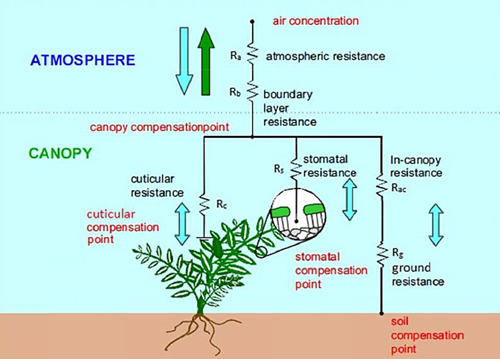|

|
|
Figure Resistance scheme implemented in the air-surface exchange model (Image by IGCAS)
|
Mercury (Hg) is a persistent, bioaccumulative pollutant released into the atmosphere from a variety of anthropogenic and natural sources. While the anthropogenic release (2000–2400Mgyr-1) have been estimated and continuously updated with reasonable consistency since the 1990s, the estimates for natural emissions have been highly uncertain (1500–5207Mgyr−1), primarily due to a lack of understanding in the air–surface exchange of Hg0.
Air–surface exchange is an important component in atmospheric mercury modeling. For terrestrial surfaces, the soil Hg evasion has been calculated using the statistical relationships obtained from the measured Hg0 flux and observed environmental factors such as temperature, solar irradiance, leaf area index, and Hg content. However, such an approach oversimplifies the role of environmental factors in the exchange process because Hg0 flux was measured only in a limited number of locations where the environmental parameters (such as soil properties and meteorology) are specific to those sites.
Although algorithms parameterizing the transport resistances at soil and foliage interfaces have been developed to calculate the multilayered, bidirectional flux through a Hg concentration gradient between ambient level and a "compensation" point inferred from the surface characteristics, the complicated model parameterization makes it difficult to understand the relative importance of model variables on the simulated flux. It also requires assumptions for numerous model variables that lack field data to estimate their values.
Based on the latest understanding of the resistance scheme of atmosphere–biosphere interface transfer, Prof. FENG Xinbing’s team at Institute of Geochemistry, CAS (IGCAS) has presented an updated bidirectional air–surface exchange model for elemental mercury vapor (Hg0), and to quantitatively examine the relative importance of the physical and environmental variables implemented in the model. Compared to the earlier mechanistic schemes, their model also includes foliage storage effect, considers photochemical reduction on foliage, and updates the resistance terms.
The researchers have performed two monthly (summer and winter) simulations to evaluate the seasonal and diurnal variability of the air–surface exchange. The base-case results show that water and soil surfaces are net sources while vegetation is a net sink of Hg0. The smaller evasion in summer is due to the stronger Hg0 uptake by vegetation. Each natural surface exhibits a different diurnal and seasonal variation.
To examine the sensitivity of flux response to changes of physical and environmental parameters in the model, the researchers have conducted the modeling experiments using a 2-level factorial design. The results indicate that atmospheric shear flows (surface wind over water and friction velocity over terrestrial surfaces), dissolved gaseous mercury (DGM) concentration, soil organic and Hg content, and air temperature are the most influential factors controlling the magnitude of the atmosphere–biosphere exchange of Hg0. However, the positive effect of friction velocity and soil Hg content on the evasion flux from soil and canopy can be greatly offset by the negative effect of soil organic content.
In their research, significant synergistic effects are also identified between surface wind and DGM level for water surface, and between soil Hg content and friction velocity for soil surface, leading to ~50% enhanced flux compared to the sum of their individual effects. In addition, the air-foliar exchange is found to be mainly controlled by surface resistance terms influenced by solar irradiation and air temperature.
For the future model improvement, the researchers point out that more research in providing geospatial distribution of Hg in water and soil will greatly improve the flux estimate. Likewise, elucidation on the kinetics and mechanism of Hg(II) reduction in soil/water and quantification of the surface resistances specific to Hg species will also help reduce the model uncertainty.
Prof. Feng Xinbing's research was supported by National "973" Program of China (2013CB430003), National Institute of Food and Agriculture, U.S. Department of Agriculture (2009-38899-20017), and State Key Laboratory of Environmental Geochemistry, IGCAS. More results have been published in Atmos. Chem. Phys., 14, 6273-6287, 2014.
(By WANG Xun)